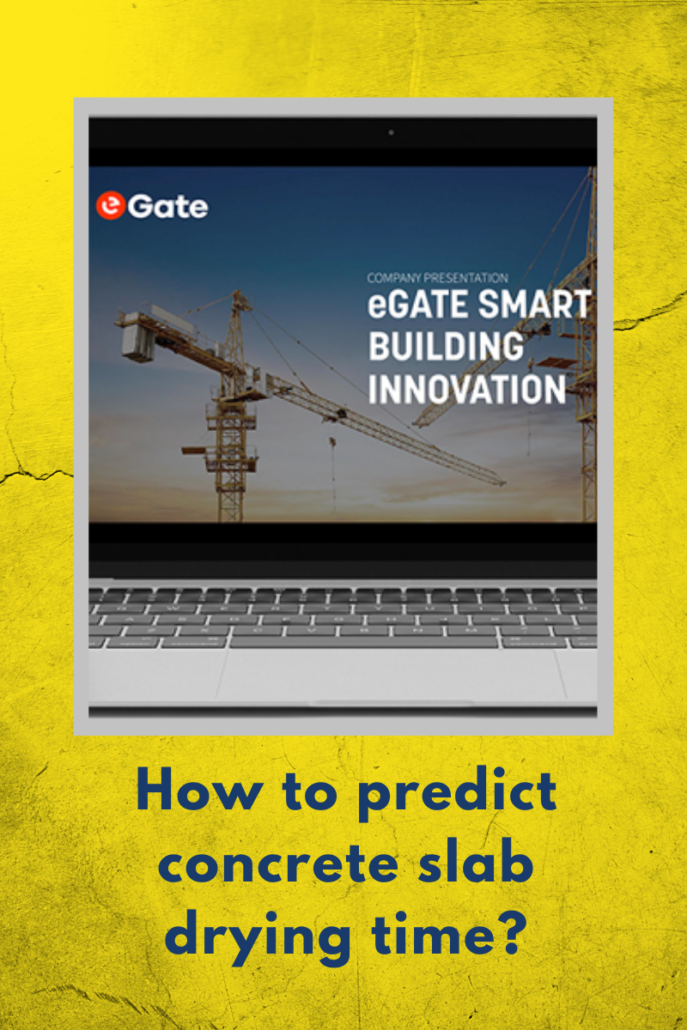
How to Predict Concrete Slab Drying Time
When scheduling a building construction project, the flooring installation and the related concrete slab drying time are significant. The industry best practice is to let the concrete dry at least 28 days per inch of the slab. For example, a 6-inch-thick concrete slab in a commercial building can take six months to reach the required level of concrete humidity, typically 75% or 85% RH, to meet the flooring material manufacturer’s warranty.
This 28-day rule of thumb assumes optimum indoor drying conditions, under 50% relative humidity and above 65°F temperature in the air, with constant airflow over the slab surface and a w/c ratio of 0.5. Especially if the moisture level in the air is high, water in the concrete evaporates very slowly, if at all, and the drying process will be slower.
Controlling Concrete Drying Time
The drying time can be expedited by controlling the ambient air temperature and humidity with external dehumidifiers and heaters and selecting a faster drying concrete mix. But at the end of the day, the only way to know if the concrete slab is dry enough is to go on the job site and measure it. The most accurate test method for this testing is described in the ASTM F2170 standard, the “in situ RH test.”
To cut the drying time for shorter schedules, installing moisture mitigation solutions, vapor barriers, and adhesives on top of the concrete surface is also possible to block the moisture from getting into the flooring material. But that introduces an additional cost to the project for the adhesives and preparation work. The question then is: should we accept the cost of the wait time until the concrete is dry, meeting the flooring manufacturer’s spec, or start the flooring project earlier and assume the cost of installing the vapor barrier? This is a difficult question to answer if one cannot forecast the date when the slab is estimated to be dry.
Live Monitoring of the Concrete Drying
Monitoring the concrete humidity continuously during the drying process would enable detecting any problems early on and controlling the environment for the optimal drying process. Continuous measurement data would also make possible accurate projections and forecasting of the drying date. However, if the drying process will take, say, four to six months, do you want to continue manually checking and measuring multiple sensors in the slab every week to re-evaluate the status?
The good news is that you don’t have to be onsite to update the ASTM 2170 measurements in today’s world of cloud-connected IoT sensors. Cloud-connected IoT RH sensors can stay installed in concrete during the entire project. They can monitor and record the concrete slab humidity, and alerts can be sent directly to your mobile phone when the desired dryness has been reached. In addition, by applying prediction algorithms and models to the real-time data, the system can forecast the day when the concrete is dry. This enables you to make decisions for scheduling and the cost assessment between the wait time and vapor barrier cost ($2/sq.ft). Real-time alerts also help you control the environment, when necessary, with extra heaters and dehumidifiers.
Selecting ASTM 2170 Probes
One key difference between commercial ASTM 2170 measurement solutions today is the use of wireless communication. Some products use the wireless connection only onsite (Bluetooth) and require job site visits to update readings from each sensor. With products that use a wide area/cellular connection, the data is automatically updated to the cloud (Cloud IoT) without anyone making sensor measurements onsite.
The other very important factor is the measurement accuracy, as ASTM 2170 standard requires +/-2%RH precision at 90%RH level. Unfortunately, that is not always available, even though many vendors promote their products being ASTM 2170 compliant.
ASTM 2170 measurement product categories

eGate Cloud IoT Sensors and Concrete Drying Prediction
An example of IoT cloud-connected ASTM 2170 sensor is eGate Nsens. The Nsens RH+Temp probe is installed according to ASTM 2170 standard method in a drilled hole in a concrete slab. But unlike in other commercial probes, eGate Nsens has a wireless Lorawan radio chip at the end of the probe. The measurement data will automatically stream live to the cloud, from where it can be reported and shared with all stakeholders on mobile phones. It does not require anyone to visit the job site for reading updates.
The eGate cloud platform includes analytics, data logging, reports, alerts and enables an unlimited number of project sites to be monitored on the same dashboard simultaneously. eGate’s U.S. patent-pending concrete drying prediction method also calculates the concrete drying forecasting curve with estimated dates for each targeted RH% level. The eGate prediction algorithm is the result of over 500 million data points that have been collected from job site concrete slab measurements over several years.
For more information please visit our website – www.sitebiotics.io
Or contact us at info@sitebiotics.io



Leave a Reply
Want to join the discussion?Feel free to contribute!